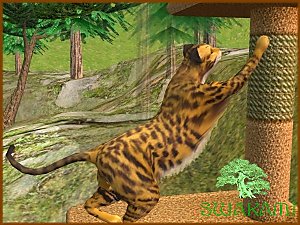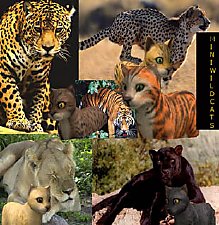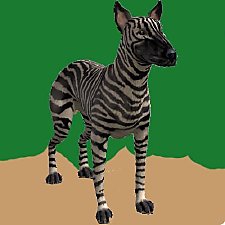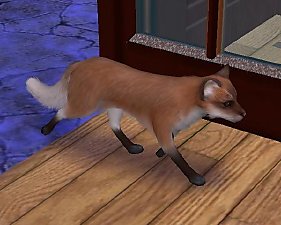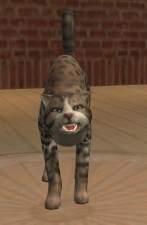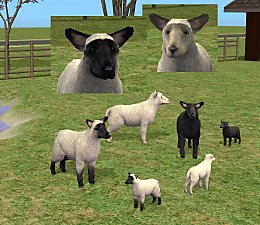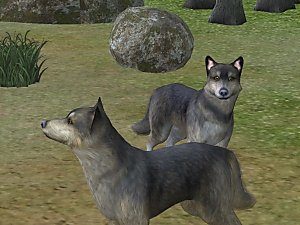 The Wildcat "Ocelot" (Leopardus pardalis)
The Wildcat "Ocelot" (Leopardus pardalis)

300px-Ocelot.jpg - width=300 height=197

Ozelot by Swakami.jpg - width=600 height=450

snapshot_32a6dd7e_d2a737e6.jpg - width=600 height=450

Ozelot Zoom.jpg - width=209 height=192

snapshot_32a6dd7e_d2a7400b.jpg - width=600 height=450

snapshot_32a6dd7e_72a73ba5.jpg - width=600 height=450

Type: Dog
Age: Adult
Size: Large
The ocelot (Leopardus pardalis),
also known as painted leopard, tigrillo or McNenney's wildcat, is a wild cat distributed over South and Central America and Mexico, but has been reported as far north as Texas and in Trinidad, in the Caribbean. It can be up to 100 cm (3'2") in length, plus 45 cm (1'6") tail length, and weighs 10-15 kg [IMG](about 20-33 pounds). While similar in appearance to the oncilla and the margay, who inhabit the same region, the ocelot is larger. It should be noted that ocelots are often called "tigrillo" in Mexico. This word, which means little tiger, is also used to describe margays, and should not be used when trying to speak of one determinated species.
The ocelot is mostly nocturnal and very territorial. They will fight fiercely, sometimes to the death, in territorial disputes. Like most felines, they are solitary, usually meeting only to mate. However, during the day they rest in trees or other dense foliage, and will occasionally share their spot with another ocelot of the same gender. When mating, the female will find a den in a cave in a rocky bluff, a hollow tree, or a dense (preferably thorny) thicket. The gestation period is estimated to be 70 days. Generally the female will have 2-4 kittens, born in the autumn with their eyes closed and a thin covering of hair.
While ocelots are well equipped for an arboreal lifestyle, and will sometimes take to the trees, they are mostly terrestrial. Prey includes almost any small animal: monkeys, snakes, rodents, fish, amphibians and birds are common prey, as are small domestic animals such as baby pigs and poultry. Almost all of the prey that the ocelot hunts is far smaller than itself. Studies suggest that they follow and find prey via odour trails, but ocelots also have very keen vision, including night vision.
They are occasionally kept as pets.






|
Ozelot.zip
Download
Uploaded: 3rd Jan 2007, 10.7 KB.
11,562 downloads.
|
||||||||
| For a detailed look at individual files, see the Information tab. | ||||||||
Install Instructions
1. Download: Click the download link to save the .rar or .zip file(s) to your computer.
2. Extract the zip, rar, or 7z file.
3. Install: Double-click on the .sims2pack file to install its contents to your game. The files will automatically be installed to the proper location(s).
- You may want to use the Sims2Pack Clean Installer instead of the game's installer, which will let you install sims and pets which may otherwise give errors about needing expansion packs. It also lets you choose what included content to install. Do NOT use Clean Installer to get around this error with lots and houses as that can cause your game to crash when attempting to use that lot. Get S2PCI here: Clean Installer Official Site.
- For a full, complete guide to downloading complete with pictures and more information, see: Game Help: Downloading for Fracking Idiots.
- Custom content not showing up in the game? See: Game Help: Getting Custom Content to Show Up.
Loading comments, please wait...
-
by robin07042005 2nd Jan 2006 at 4:59am
-
by Janet_Davis 20th Oct 2006 at 10:05pm
 +1 packs
20 48.1k 35
+1 packs
20 48.1k 35 Pets
Pets
Pets » Animals » Other Species
-
by chocobread 21st Oct 2006 at 8:23pm
 +1 packs
6 13.3k 1
+1 packs
6 13.3k 1 Pets
Pets
Pets » Animals » Other Species
-
by vVv_klawz_vVv 13th Mar 2007 at 12:45am
 +1 packs
3 12.7k 3
+1 packs
3 12.7k 3 Pets
Pets
Pets » Animals » Other Species
-
by mickeymouse254 10th Jul 2007 at 12:41am
 +1 packs
5 16.5k 8
+1 packs
5 16.5k 8 Pets
Pets
Pets » Animals » Other Species
-
AMjoie Wilds Breeds: Sheepish, Little Dear, Foxer, Wildcat
by amjoie 5th May 2009 at 12:28am
 +1 packs
19 68.2k 67
+1 packs
19 68.2k 67 Pets
Pets
Pets » Animals » Other Species
-
by calinours 15th Mar 2011 at 1:08am
 +1 packs
15 47.6k 77
+1 packs
15 47.6k 77 Pets
Pets
Pets » Animals » Other Species
Packs Needed
| Base Game | |
|---|---|
 | Sims 2 |
| Expansion Pack | |
|---|---|
 | Pets |

 Sign in to Mod The Sims
Sign in to Mod The Sims The Wildcat "Ocelot" (Leopardus pardalis)
The Wildcat "Ocelot" (Leopardus pardalis)



